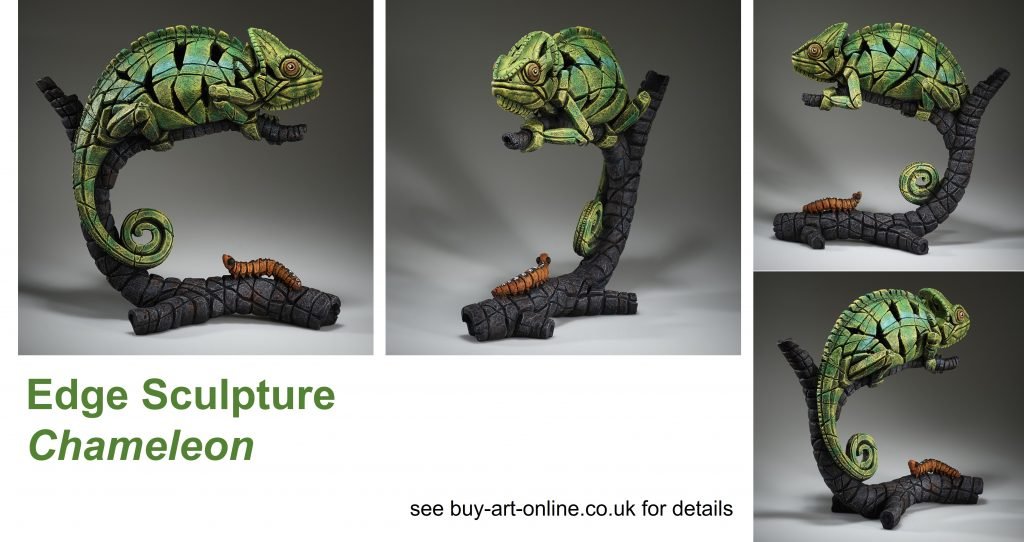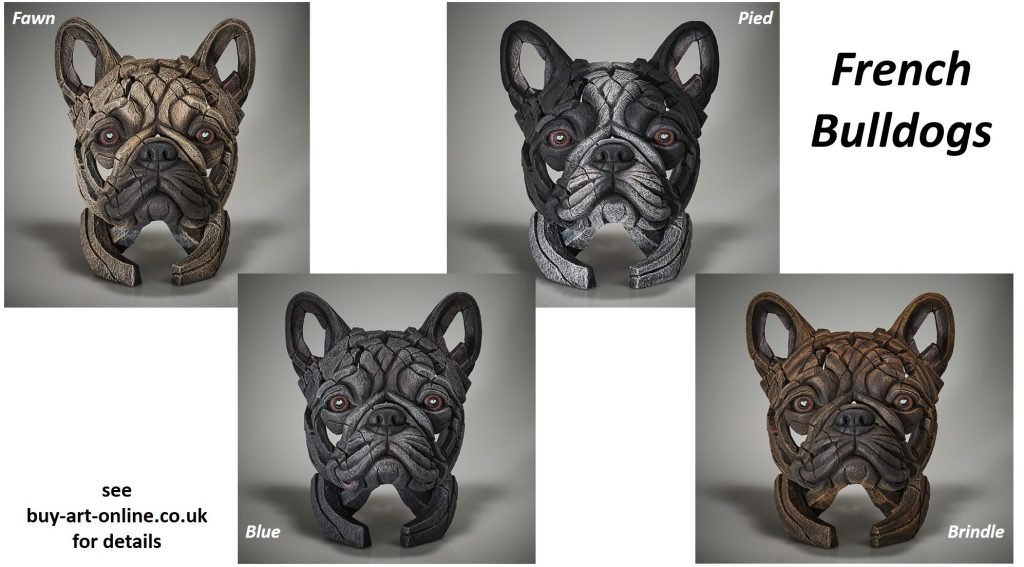The Edge Sculpture Collection is under continual development with new Edge Sculptures being developed by Matt Buckley, the designer, twice a year. At the same time, existing sculptures are sometimes retired or discontinued when they become less popular and to make way for new sculptures. In this way, the Collection is constantly being updated and kept current.
The following describes some of the animals depicted in the Edge Sculpture Collection. These are either complementary to existing animal sculptures which create a subset of the Edge Sculpture Collection and/or new Edge Sculptures that have been recently released. The current range of Edge Sculptures is always shown in the online Edge Sculpture Store.
African Wildlife Edge Sculptures
Cobra Snakes | Giraffe | Rhinocerous
Cobra Edge Sculptures
Copper Cobra | Desert
Cobra is the common name of various snakes. All of the known cobras are venomous and many are capable of rearing upwards and producing a hood when threatened.

Brown Rhinocerous or White Rhinocerous
Rhinoceros means ‘nose-horned’ and are some of the largest species able to reach or exceed one tonne in weight. They have a herbivorous diet, small brains (400–600 g) for mammals of their size, one or two horns, and a thick (1.5–5 cm) protective skin formed from layers of collagen. They generally eat leafy material, although their ability to ferment food allows them to subsist on more fibrous plant matter when necessary.

The giraffe has intrigued various cultures, both ancient and modern, for its peculiar appearance, and has often been featured in paintings, books, and cartoons. It is an African mammal and the tallest living terrestrial animal that are able to acquire nutrients from plant-based food. The giraffe’s chief distinguishing characteristics are its extremely long neck and legs, its horn-like protuberances and its distinctive coat patterns.

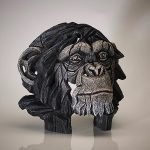
Ape Edge Sculptures
Chimpanzee
Gorillas
Orangutans
The chimpanzee also known as simply “chimp“, is a species of great ape native to the forests and savannahs of tropical Africa. The chimpanzee is covered in coarse black hair, but has a bare face, fingers, toes, palms of the hands, and soles of the feet. It weighs 40–70 kg for males and 27–50 kg for females and stands 100 to 150 cm tall. It lives in groups that range in size from 15 to 150 members, although individuals travel and forage in much smaller groups during the day. The species lives in a strict male-dominated hierarchy, where disputes are generally settled without the need for violence. Nearly all chimpanzee populations have been recorded using tools, modifying sticks, rocks, grass and leaves and using them for hunting and acquiring honey, termites, ants, nuts and water. The species has also been found creating sharpened sticks to spear small mammals.
Gorilla Edge Sculptures
Gorilla Head | White Gorilla Head | Baby Gorilla | Sitting Gorilla | Baby Gorilla Snowflake
Gorillas are ground-dwelling, predominantly herbivorous apes that inhabit the forests of central Sub-Saharan Africa. They are the largest living primates. The DNA of gorillas is highly similar to that of humans, from 95 to 99% depending on what is included, and they are the next closest living relatives to humans after the chimpanzees and bonobos. Their natural habitats cover tropical or subtropical forests in Sub-Saharan Africa and a wide range of elevations. Gorillas move around by knuckle-walking with adult males weighing 136 to 227 kg while females weigh 68–113 kg. Adult males are 1.4 to 1.8 m tall, with an arm span that stretches from 2.3 to 2.6 m, and are known as silverbacks due to the characteristic silver hair on their backs reaching to their hips.
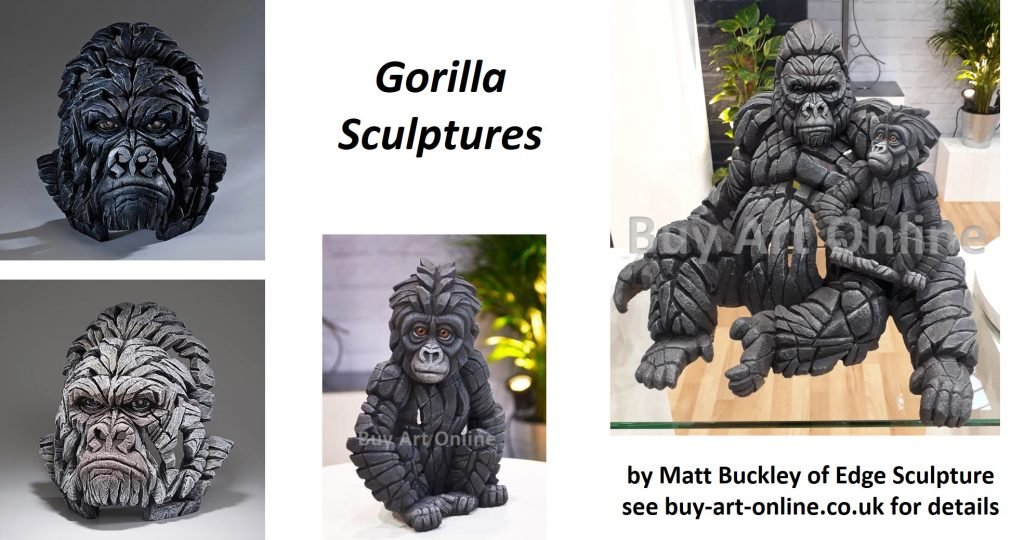
Orangutan Edge Sculptures
Orangutan | Baby Orangutan | Baby Oh Orangutan | Orangutan Bust
Orangutans are the most arboreal of the great apes and spend most of their time in trees. Their hair is reddish-brown, instead of the brown or black hair typical of gorillas and chimpanzees. Males and females differ in size and appearance. Dominant adult males have distinctive cheek pads and produce long calls that attract females and intimidate rivals. Orangutans are the most solitary of the great apes, with social bonds occurring primarily between mothers and their dependent offspring, who stay together for the first two years. Fruit is the most important component of an orangutan’s diet; however, the apes will also eat vegetation, bark, honey, insects and even bird eggs. They can live over 30 years in both the wild and captivity.

Baby Edge Sculptures
Baby Gorilla & Snowflake | Tiger Cubs | Baby Calf Elephant | Baby Orangutan | Baby Oh Orangutan | Bear Cub | Baby Chimpanzee | Panda Cub

Bears by Edge Sculpture
Grizzly Bear | Bear Cub | Polar Bear | Panda Bear | Panda Cub

The Grizzly Bear is also known as the North American brown bear or simply grizzly, and is a large population of the brown bear inhabiting North America.Most adult female grizzly bears weigh 130–180 kg, while adult males weigh on average 180–360 kg. There average total length is 198 cm (6.50 ft), with an average shoulder height of 102 cm (3.35 ft) and hindfoot length of 28 cm (11 inch).Although variable in color from blond to nearly black, grizzly bear fur is typically brown with darker legs and commonly white or blond tipped fur on the flank and back.
Polar Bears native range is within the Arctic Circle, encompassing the Arctic Ocean, its surrounding seas and surrounding land masses. It is a large bear with the adult male weighing around 350–700 kg while the adult female is about half that size. Polar bears are the largest land carnivores currently in existence with many body characteristics adapted for cold temperatures, for moving across snow, ice and open water, and for hunting seals, which make up most of its diet.Although most polar bears are born on land, they spend most of their time on the sea ice. The Polar bear hunts their preferred food of seals from the edge of sea ice, often living off fat reserves when no sea ice is present. Because of their dependence on the sea ice, polar bears are classified as marine mammals.
The Panda is a bear native to south central China. It is characterised by large, black patches around its eyes, over the ears, and across its round body. Bamboo shoots and leaves make up more than 99% of its diet. Giant pandas in the wild will occasionally eat other grasses, wild tubers, or even meat in the form of birds, rodents, or carrion. In captivity, they may receive honey, eggs, fish, yams, oranges, or bananas along with specially prepared food.
Big Cats from Edge Sculpture
Lions | Panthers | Tigers
Lions from Edge Sculpture
Savannah or White | Limited Edition Black
The lion is a muscular, deep-chested cat with a short, rounded head, a reduced neck and round ears, and a hairy tuft at the end of its tail. Adult male lions have a prominent mane, which is the most recognisable feature of the species. With a typical head-to-body length of 184–208 cm they are larger than females at 160–184 cm. Lions are a social species, forming groups called prides. A lion pride consists of a few adult males, related females and cubs. Groups of female lions usually hunt together, preying mostly on large mammals with hoofs. The lion is an apex predator and typically inhabits grasslands and savannas, but is absent in dense forests.


Panther Edge Sculptures
General Edition Black or Limited Edition Colours
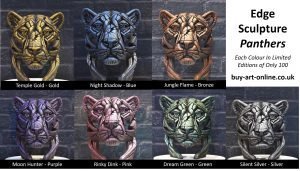
The Black Panther is a big cat of any species, but most commonly a jaguar or a leopard whose coloration is entirely black. This may have originated from the Latin name Panthera for the big cats and was probably shortened from Black Panthera to Black Panther.
Tiger Edge Sculptures
Orange or Siberian Tiger | Tiger Cubs
The Tiger is the largest cat species and is most recognisable for its dark vertical stripes on orange-brown fur with a lighter underside. It is an apex predator, primarily preying on deer and wild boar. It is territorial and generally a solitary but social predator, requiring large contiguous areas of habitat, which support its requirements for prey and rearing of its offspring. Tiger cubs stay with their mother for about two years, before they become independent and leave their mother’s home range to establish their own.

Bird Edge Sculptures
Eagle | Barn Owl | Tawny Owl | Penguin | Puffin | Robin | T-Rex

The Barn Owl is the most widely distributed species of owl and one of the most widespread of all birds, found almost everywhere in the world. Barn owls specialise in hunting animals on the ground and nearly all of their food consists of small mammals which they locate by sound, their hearing being very acute. They usually mate for life unless one of the pair is killed, when a new pair bond may be formed. Breeding takes place at varying times of year according to the locality, with a clutch, averaging about four eggs, being laid in a nest in a hollow tree, old building or fissure in a cliff. The female does all the incubation, and she and the young chicks are reliant on the male for food. When large numbers of small prey are readily available, barn owl populations can expand rapidly.
The Tawny Owl is a stocky, medium-sized owl commonly found in woodlands. The tawny owl has underparts that are pale with dark streaks, and the upper parts are either rufous, brown or grey. This nocturnal bird of prey hunts a wide variety of prey species, but usually primarily takes small mammals such as rodents. Tawny owls usually hunt by dropping from a perch to seize their prey, which they typically swallow whole.Although many people believe this owl has exceptional night vision, its retina is no more sensitive than a human’s and its asymmetrically placed ears are key to its hunting by giving it excellent directional hearing. Its nocturnal habits and eerie, easily imitated call, have led to a mythical association of the tawny owl with bad luck and death.

Penguins are a group of aquatic flightless birds. They live almost exclusively in the Southern Hemisphere with only one species found north of the equator. Highly adapted for life in the water, penguins have dark and white plumage and flippers for swimming. Most penguins feed on krill, fish, squid and other forms of sea life which they catch while swimming underwater. They spend roughly half of their lives on land and the other half in the sea.
The European Robin is known simply as the Robin in the British Isles and is about 12.5–14.0 cm (5.0–5.5 inches) in length. The male and female are similar in colouration, with an orange breast and face lined with grey, brown upper-parts and a whitish belly. It is found across Europe, east to Western Siberia and south to North Africa; it is sedentary in most of its range except the far north.
Puffins are any of three species of small birds that are notable for their ability to “fly” under water as well as in the air. Although they are excellent swimmers and divers, their walking appears clumsy. They have a brightly colored beak during the breeding season and feed primarily by diving in the water. Puffins breed in large colonies on coastal cliffs or offshore islands, nesting in crevices among rocks or in burrows in the soil. All puffin species have predominantly black or black and white plumage, a stocky build, and large beaks. They shed the colorful outer parts of their bills after the breeding season, leaving a smaller and duller beak. Their short wings are adapted for swimming with a flying technique under water. In the air, they beat their wings rapidly (up to 400 times per minute) in swift flight, often flying low over the ocean’s surface.
Eagle & T Rex Edge Sculptures
Bald or Golden Eagle | Tyrannosaurus Rex
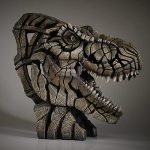
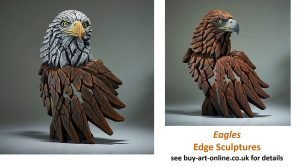
The Bald Eagle is a bird of prey found in North America. It is found near large bodies of open water with an abundant food supply and old-growth trees for nesting.The bald eagle is an opportunistic feeder which subsists mainly on fish, which it swoops down and snatches from the water with its talons. It builds the largest nest of any North American bird and the largest tree nests ever recorded for any animal species, up to 4 m (13 ft) deep, 2.5 m (8.2 ft) wide, and 1 ton in weight. Bald eagles are not actually bald ; the name derives from an older meaning of the word, “white headed”. The adult is mainly brown with a white head and tail ; as weell as a large hooked beak. The sexes are identical in plumage, but females are about 25 percent larger than males.
The Golden Eagle is one of the best-known birds of prey in the Northern Hemisphere and is the most widely distributed species of eagle. These birds are dark brown, with lighter golden-brown plumage on their napes. Golden eagles use their agility and speed combined with powerful feet and massive, sharp talons to snatch up a variety of prey, mainly hares, rabbits and ground squirrels. They maintain home ranges or territories that may be as large as 200 km2 (77 sq mi). They build large nests in cliffs and other high places to which they may return for several breeding years.
The Tyrannosaurus Rex or T-Rex lived throughout what is now western North America, 68-66 million years ago. It had a massive skull balanced by a long, heavy tail. Relative to its large and powerful hind limbs, the T-Rex had forelimbs that were short but unusually powerful for their size with two clawed digits. The most complete specimen measures up to 12.3 m (40 ft) in length, up to 3.66 meters (12 ft) tall at the hips, and according to most modern estimates 8.4 metric tons (9.3 short tons) to 14 metric tons (15.4 short tons) in weight. The T-Rex is still among the largest known land predators and is estimated to have exerted the strongest bite force among all terrestrial animals.
Canine Edge Sculptures – Dog and Wolf
Bull Dog in Fawn or White | Bull Terrier in Red or Tri Colour | Grey or Timber Wolf | Bull Terrier Heads | French Bulldogs
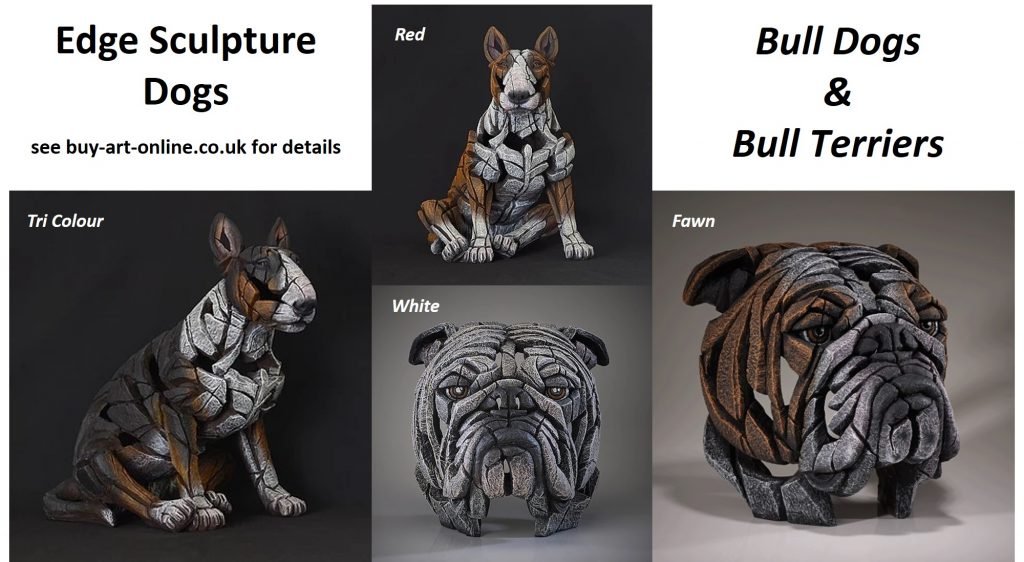

Cat Edge Sculptures
Sitting Cat in Black, Ginger, Tabby or White | Standing Cat in Black, Ginger or White
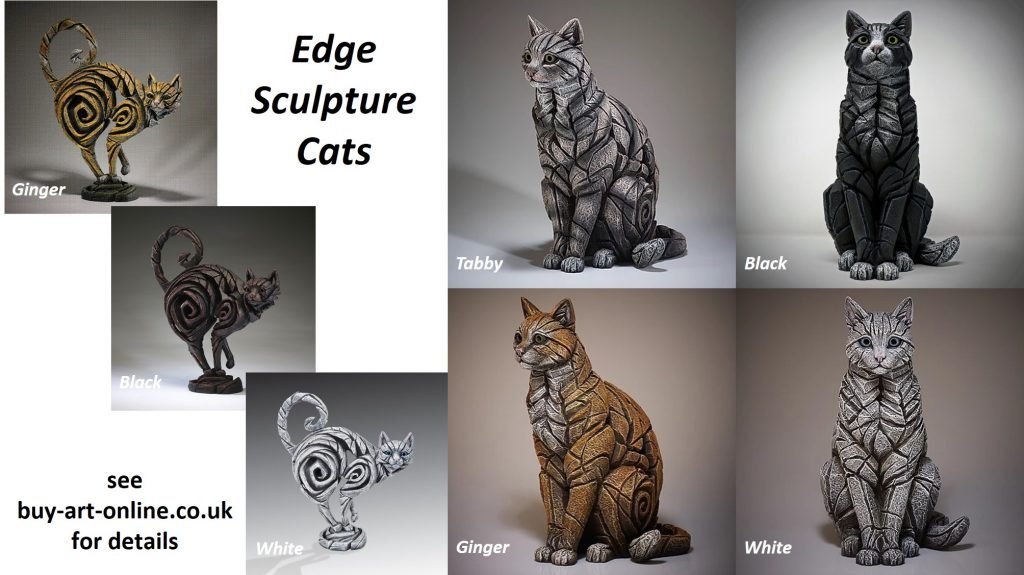
Countryside
Hare | Hare – Stargazer | Fox | Squirrel Red or Grey | Hedgehog
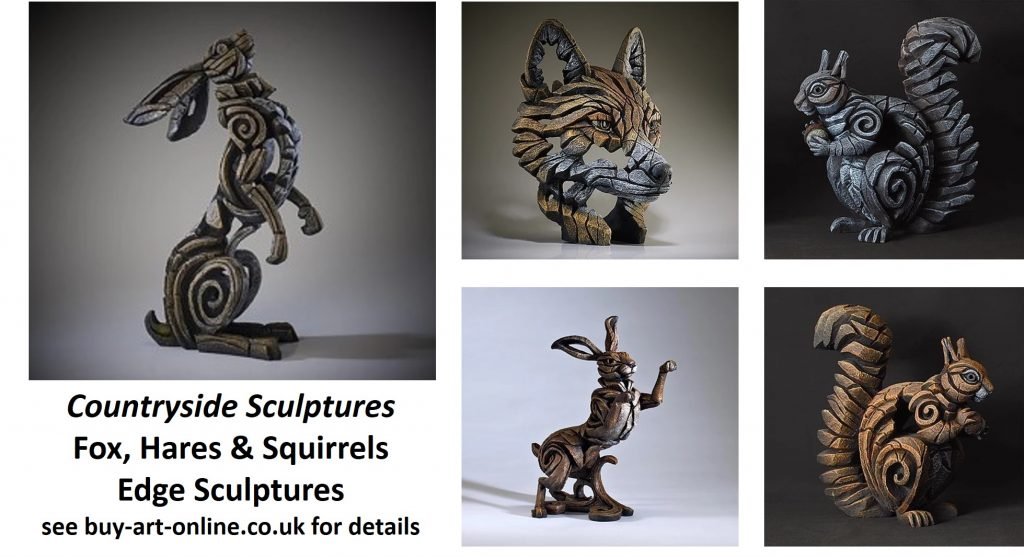
Dragon Edge Sculptures
Red or Green | Heraldic in Red, Golden or Brimstone


Egyptian Edge Sculptures
Tutankhamun | Cleopatra – Eqyptian Blue | Cleopatra – Queen of the Desert

Elephant Edge Sculptures
African Elephant | Baby Calf Elephant | Brown or White Elephants
Elephants are mammals and the largest existing land animals. Three species are currently recognised: the African bush, African forest and Asian elephant. The African elephants have larger ears and concave backs, whereas Asian elephants have smaller ears, and convex or level backs. Distinctive features of all elephants include a long trunk, tusks, large ear flaps, massive legs, and tough but sensitive skin. The trunk is used for breathing, bringing food and water to the mouth, and grasping objects. Tusks, which are derived from the incisor teeth, serve both as weapons and as tools for moving objects and digging. The large ear flaps assist in maintaining a constant body temperature as well as in communication. The pillar-like legs carry their great weight.
Elephants are scattered throughout sub-Saharan Africa, South Asia, and Southeast Asia and are found in different habitats, including savannahs, forests, deserts, and marshes. They are herbivorous, and they stay near water when it is accessible. Other animals tend to keep their distance from elephants; the exception is their predators such as lions, tigers, hyenas, and wild dogs, which usually target only young elephants (calves). Female elephants(cows) tend to live in family groups, which can consist of one female with her calves or several related females with offspring. The groups, which do not include bulls, are led by the (usually) oldest cow, known as the matriarch.

Horse Edge Sculptures
Horse Busts in Bay, Black, Palomino or White | Standing Bay Horse

Marine Edge Sculptures
Penguin | Polar Bear | Sea Turtle | Shark | Octopus

Masks from Edge Sculpture ( Wall Hanging and Base Mounted )
Japanese Hannya Mask in Antique White or Red or Nesuke Gold
Venetian Carnival Masks as Masquerade or Red & Gold or Teal
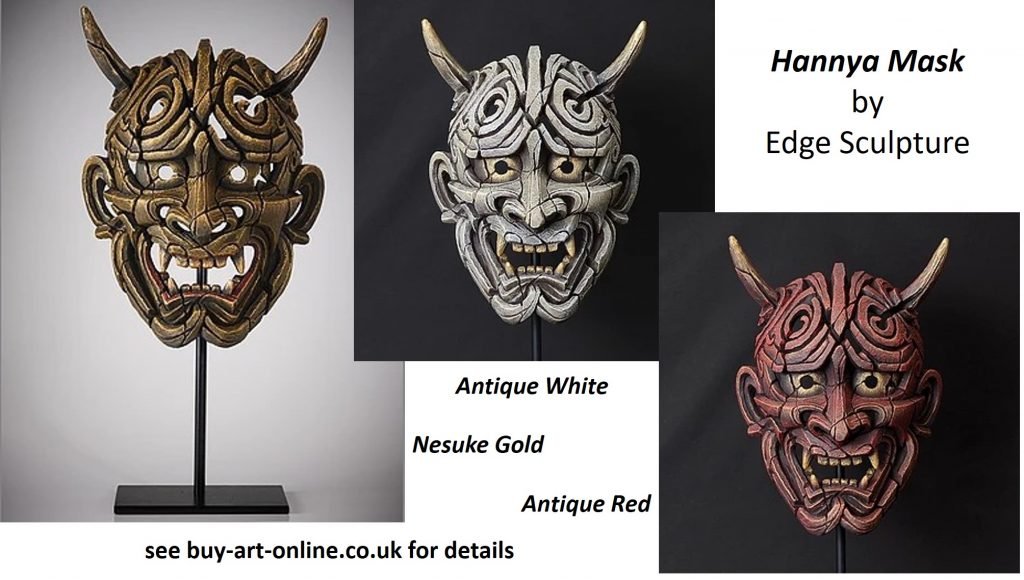

Mythical Figures by Edge Sculptures
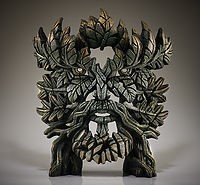

Angel
Venus
Wood Elf

Venus Edge Sculptures
Stone or Teal Venus

Wood Elf Edge Sculptures
Mistral, Aqua or Leaf Wood Elf

Other Edge Sculptures
Sloth | Spartan | Chameleon
Sloths are a group of mammals noted for their slowness of movement. They spend most of their lives hanging upside down in the trees of the tropical rainforests of South and Central America and are considered to be most closely related to anteaters.

Spartan Edge Sculptures
Spartan in Slate or Verdi Gris

Chameleon
Chameleon
Chameleons are distinguished by their feet, their swaying gait, and crests or horns on their brow and snout. Most species, the larger ones in particular, also have a prehensile tail which is capable of grasping or holding objects. Chameleons’ eyes are independently mobile, but in aiming at a prey item, they focus forward in coordination, affording the animal stereoscopic vision. Chameleons are adapted for climbing and visual hunting. They live in warm habitats that range from rainforests to deserts with various species occurring in Africa, Madagascar, Southern Europe and across Southern Asia.
